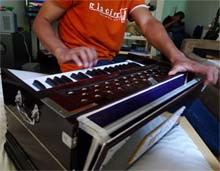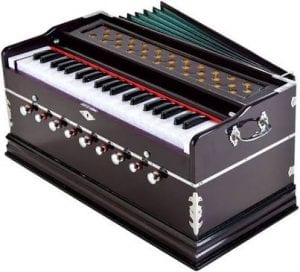In India the harmonium or reed-organ, or “the poor man`s pipe-organ,” belongs to the same family of instruments as the mouth-organs and accordion-type instruments. It has freely moving reeds (as well as rising reeds) on which a patent was taken out in 1840 by the French instrument maker, Alexandre Debain.
It became an extremely popular instrument in the United States and Europe in the second half of the nineteenth century, used mainly for accompanying the voice in the home and in church, since it had the tone of a pipe-organ without the bulk or the enormous expense.
The harmonium has a piano-like body which usually is elaborately carved in the fashion of the day. Harmonium has two foot-pedals connected to two bellows that provide air supply and keyboard has a range of five octaves. Below the keyboard there are two siphon paddles operated by the player`s knees. One initiates sort of swells mechanism while the other is used for musical emphasis like a general crescendo.

In India harmonium was introduced by the missionaries who brought these percussion instruments in the nineteenth century. Since then the instrument was portable and easy to learn and handle, it became quickly popular. The genres of Indian music, specially North Indian music, harmonium plays an important role. However it was modified later keeping in mind the Indian need which is a hand held one and is generally played by keeping it on the floor. Besides music, Indian harmonium carved a place for itself on stage as well. Especially, in Parsi and Marathi theatre it was widely used and the role of the harmonium was usurped to some extent by the electric organ in the second half of the twentieth century, though not for religious music.
Importance
The popularity of the Indian harmonium had many people believing that it had originated from the country. When the British brought the instrument to India, the foot pedal stayed; however, a hand-pump version was introduced in India it self. This was beneficial for the Indians as they primarily sat on the floor to play their instruments. Often Indian musicians sing while playing their instruments, and the harmonium sounded well with vocals. Indian music generally is melodic, and musicians usually don’t play chords on their instruments. Since Indians only needed one hand to play individual keys on the instrument, they had a free hand to pump air, making the whole process of using the harmonium easy to learn.
Also published on Medium.

